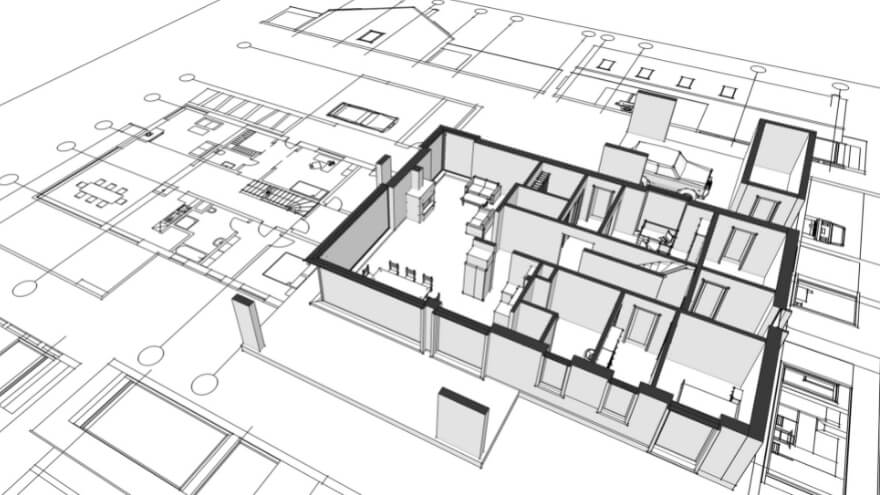6 Reasons to Have a Good Website Structure
Have you ever visited a website that was disorganized and confusing to navigate?
How did it make you feel as a visitor?
Well, a good website structure plays a crucial role in how users interact with a site and can significantly impact their overall browsing experience.
In this article, you’ll discover several reasons to care about your website structure and why you should care about it as early as possible for positive outcomes.
Don’t want to read?
Here’s the audio retranscription:
What is a Website Architecture?
A website architecture refers to a website’s structure and organization, determining how its components and pages are linked and interact.
A website’s blueprint guides its design, layout, navigation, and functionality, contributing to its overall browsing experience.
Clean Navigation
Having a website with a clean navigation system is undoubtedly the first reason to care about a good structure.
The navigation typically involves refined menus with limited available options that are intuitive to all users and, eventually, a breadcrumb that always guides the user through the website’s architecture by showing where the user’s active displayed page regarding the entire site.

While having a menu is a common standard on most websites, except landing pages, a menu can display its options in multiple formats:
- It can display its options with dropdowns, allowing users to select what they want in a hierarchized style. These menus are ideal for most professional websites and blogs.
- It can display all its options in mega menus in a simple view for a better reading of all possibilities by final users. These menus are ideal for medium to large websites with many pages, such as e-commerce stores.
- It can display its options with primary links for straightforward navigation. These simplified menus are ideal for small sites with little content, like showcase websites.
Establishing the right website structure from the beginning can greatly help define the most suitable menu for your company site.
Then, there are breadcrumbs, which are basically organized links that show the user’s current location throughout a website and also contribute to smooth its navigation.
They form an accessible and efficient way to navigate through the website’s related content with simple links to other pages.
Simplified Content Hierarchy
Caring about a website’s structure can also benefit its overall usability, thanks to well-organized and hierarchized content.
Most online websites already feature essential elements that initially favor such a good structure.
Among these possibilities, you can find:
- Headings and sub-headings. They are some of the most efficient ways to keep the content readable for all users. With 6 levels of organization commonly utilized on the web and standardized for pages and posts, the produced content can be organized in multiple methods to make it clear for reading and alter its understanding.
- Categories. They are additional ways to organize your website content by grouping similar content into one relevant entity. They are usually efficient methods to split and manage its services and products more accurately.
- Tags. Even though tags are less commonly used or handy than the other possibilities, they can help arrange your content as well. They are more often used for articles rather than classic pages to provide some guidance to the readers.
- Table of contents. A table of contents present in all your articles might also be handy for better structuring your content, especially when your piece of content is long and heavily detailed. A common good practice when using one in an article is to limit the number of headings to a maximum of 3 levels.
By implementing at least one of the previous options, you can make the navigation more fluent and, therefore, more appreciated by your website’s visitors.
Receive actionable tips to enhance your business processes and exclusive offers right into your inbox!
Well-Formatted URL Structure
The way your website’s URLs are formatted also plays an essential role in your site’s ability to maintain a certain coherence.
It’s commonly a good practice to keep them as easy to read and understand as possible.
One of the most effective strategies for achieving these results is to keep your URLs concise, containing only the necessary information for perfect understanding.
Keeping them as short as possible also makes your content URLs more easily memorable and shareable by your visitors, resulting in many other visibility benefits.
But well-formatted URLs also don’t include uncommon characters or symbols.
That’s one of the main reasons most websites use hyphens to separate their important words in URLs instead of underscores.
But this example is only one of many, as some characters, such as question marks or equal symbols, should be used only in specific cases.
Keeping these 2 easy good practices in mind while defining your site’s URLs could save you many working hours later on, especially when your activities and your produced content grow.
Search Engine Discovery
Another good reason to always care about a website structure is the benefits you can get from it by making your platforms more friendly for search engines crawlers.
As understandable as it is for your visitors to get a website with straightforward navigation, having one with well-organized and hierachized pieces of content also guide search engines to correctly localise your content.
It also helps by requiring fewer resources to browse your website and discover all its content, making them more willing to cover all the content instead of a limited part.
It might seem trivial, but browsing your site entirely with their robots quickly becomes a huge challenge for search engines when your site starts to have many pages and content.
That’s where getting a well-done architecture from the beginning is technically an advantage, as much for the search engine’s ability to scope your content than for its readability and visibility.
Efficient Content Visualization
A well-organized site can help you quickly identify repetitive and duplicate content, which can help you save time by avoiding creating similar content and also contribute to your SEO efforts when specific actions are taken.
So, your incoming website’s pieces of content and page roadmap are easier to plan and more willing to provide the results you expect from these kinds of campaigns.

And that’s it for this article!
What truly matters here is that your website’s architecture is like the foundation of a building.
A stable and functional website is not just a luxury.
It’s a necessity.
And the key to achieving this lies in your website’s architecture.
By taking some of the actions described above in your own project, you might notice some positive outcomes contributing to a better overall user experience.







